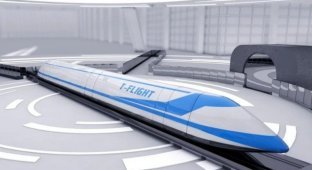A magnetic levitation train with a speed of 1000 km/h and 5G: China is developing Hyperloop! (6 photos)
Chinese researchers are making rapid progress in developing vacuum magnetic levitation trains capable of reaching speeds of up to 1,000 km/h. To address the communication challenges associated with transonic speeds, they are also implementing 5G technology to ensure reliability and efficiency. 
China is approaching the era of bullet trains!
China is pushing the boundaries of high-speed rail technology with an ambitious magnetic levitation train project that could revolutionize domestic travel. 
In the near future, passengers in China will be able to watch ultra-high-definition videos or play online games on their smartphones while traveling at 1,000 km/h on high-speed magnetic levitation trains.
Today, China’s high-speed trains travel at 350 km/h and support 5G connectivity even in long tunnels. And while China’s next-generation high-speed trains are still in development, they are designed to exceed the speed of commercial airliners.
These trains will travel through near-vacuum tubes using magnetic levitation. But maintaining communication between phones and base stations at near-sonic speeds presents a serious challenge. 
As the train moves, the signal frequency shifts, disrupting the stability of the high-frequency signals needed to transmit data. Installing base stations in near-vacuum tubes is also challenging: if the antenna is displaced by vibrations, it could compromise the operation of the high-speed train.
Researchers at Southeast University, led by Professor Song Techeng of the National Laboratory of Mobile Communications, have proposed a solution to simplify the installation of base stations by running two parallel cables along the inner wall of a pipe, the South China Morning Post reports.
These specialized cables can emit electromagnetic signals, ensuring a continuous and stable connection between smartphones and mobile networks. Thus, by using efficient coding techniques and fine-tuning key signal parameters, interference caused by frequency shifts can be minimized. 
Initial computer simulations confirm that this approach provides stable 5G data transmission.
Researchers in Shanxi Test Train Propulsion Systems!
High-speed traction tests of full-scale propulsion system prototypes have recently begun at the world's largest magnetic levitation train research base in Datong, Shanxi Province. 
A number of Chinese cities are currently seeking approval from Beijing to build the first commercial magnetic levitation train line. This ground transportation technology, known as Hyperloop, was originally proposed by Tesla CEO Elon Musk.
However, China is now the only country actively pursuing the technology, after Musk abandoned the project late last year due to technological and financial issues.
China has invested heavily in high-speed rail networks over the past 15 years, building up expertise in research, development, design and advanced manufacturing. Experts believe these resources can now be used to early-stage development of Hyperloop technology, which China has already piloted. 
Among the future options for new Hyperloop lines are the Beijing-Shijiazhuang route, which aims to relieve congestion on existing transport routes near the capital, and the Guangzhou-Shenzhen line, which would connect two major economic hubs in the Asia-Pacific region and potentially connect them to the rest of the world.
The first Hyperloop line is expected to be operational by 2035, although significant work remains to be done on safety, regulation, and infrastructure.
























